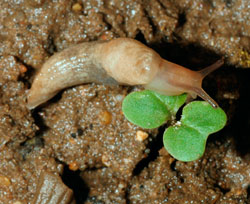Keep an eye on slug activity

Recent rainfall has attracted slugs to the soil surface and experts are urging growers to keep a close eye out for signs of activity.
They are also advising growers to brush up on stewardship guidelines to cut the risk of metaldehyde entering watercourses when treatment becomes nescessary.
Before the rain, slugs had retreated deep into the soil profile and pressure was very low, says ProCam’s David Ellerton. “As a result, slugs have slipped off the radar and some growers are neglecting to check fields.”
But now the threat is increasing and it is critical that growers realise this, he says. “Monitor crops carefully and don’t back off. Cereals will be at risk until tillering and oilseed rape until it reaches the three to four leaf stage.”
| Guidelines for pellet use
|
|---|
Mild weather will also increase activity, he says. “Populations can multiply incredibly quickly and at different rates so it’s important to check all fields, not just the ones that are convenient.” Cloddy areas will be particularly vulnerable, he adds.
Using a range of monitoring techniques such as trapping, test baiting and visual monitoring will give the most accurate results, he notes.
According to East Anglian agronomist Colin Myram, rain is also causing dormant slug eggs to hatch, contributing further to slug numbers. “Some will have been laid as far back as July.”
Seed hollowing will be the main risk for cereals, he says. “But as soils start to cool down wheat plants will take longer to come through and will be susceptible to slug damage.”
Test baiting is the most practical approach to identify slug activity, he says. “Apply a low dose of pellets to a small area and go back the following day. If you find a significant number of dead slugs, go back with a full application.”
But growers should be very measured in their approach to applying slug pellets, he warns. “Use the minimum dose to give effective control and stick to metaldehyde stewardship guidelines.” Growers should avoid spreading before heavy rain is forecast as it could push metaldehyde straight through soil channels, he adds.
The dry autumn has been good for metaldehyde stewardship so far and reduced the risk of metaldehyde reaching water courses, he says. “All reports have shown levels to be lower than the threshold value.”
Independent agronomist Tod Hunnisett prefers test baiting over trapping to indicate slug pressure. “Trapping can give a false sense of slug pressure and mash traps are not as effective as banned metaldehyde base traps.” Going out at night with a torch to monitor slug numbers is also an effective technique, he adds.
Growers must stick to metaldehyde guidelines and not blanket apply pellets, he warns. “It is not worth taking any risks.”


